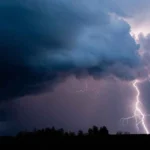
The Paricutin volcano, also known as the ‘Volcan de Paricutin,’ is located in the Mexican state of Michoacan. It is one of the World’s Seven Natural Wonders. It is famous for being the Northern Hemisphere’s youngest volcano, forming in a farmer’s cornfield. The volcano’s lava flow engulfed the Mexican villages of Paricutin and San Juan Parangaricutiro.
The villagers of Paricutin heard loud rumblings in the ground and felt the ground shake two weeks before the sudden growth of the Paricutin volcano.
Dionisio Pulido, a Tarascan Indian farmer, and his family discovered a hot mound of soil growing in their cornfield on the night of February 20, 1943.
Mr. Pulido’s field suddenly rose 6 feet (2 m), spewing ash and sulphur fumes into the air. A volcano erupted.
Later that night, the mound had grown into a small volcanic cone, spewing hot ash and flames up to 2,625 feet (800 meters) into the air.
After only one day, the volcano had risen to 164 feet (50 meters), and within a week, it had risen to 500 feet (150 meters). The volcano erupted again, spewing ash, smoke, and sulfur fumes.
The temperature of the gas erupting from the vent ranged from 1,879°F to 1,940°F. (1,026 to 1,060 °C).
Five days after the volcano grew and erupted, lava began to flow from the volcano’s vent onto the surrounding land.
The lava flow has a temperature of 1,958°F (1,070°C) and is moving at a speed of 196 feet/minute (60 meters/minute).
People in the villages of Paricutin and San Juan Parangaricutiro were unable to stay due to the thick smoke, ash, sulfur fumes, and lava. Over 7,000 people were forced to leave their homes and relocate.
The first year of the volcano’s existence was the most active, with 90% of the lava, sulfur, and other gases released underground. The volcano had grown to a height of over 1,000 feet (330 meters).
The volcano’s ash cloud rose to 8 kilometers in the air, and ash fell in the streets of Mexico 186 miles (300 kilometers) east of the volcano.
The Paricutin volcano is located at Longitude 19o5’N and Latitude102o2’W and is part of the Michoacan-Guanajuato volcanic belt, which covers an area of 15, 444 square miles (40,000 km2).
There are over 1,000 cinder cones and 378 medium-sized volcanoes in this volcanic region.
Paricutin volcano is also known as a cinder cone volcano. These are the most common types of volcanic landforms on the planet.
By 1944, the villages of Paricutin and San Juan Parangaricutiro had been engulfed by volcanic lava, with only the church tower of San Juan visible 2.8 miles (4.5 kilometers) away.
Lava cools and hardens to form basalt, a hard rock.
From 1943 to 1952, the volcano erupted on a regular basis. This means that scientists (known as volcanologists) have been able to study the birth, activity, and death of a volcano.
The Paricutin Volcano is now classified as an extinct volcano, meaning it is no longer active.
The volcano’s height has now risen to 10,400 feet (3,170 m).
The volcano was first climbed in 1943.









